Impossible? Maybe. But let’s try to explain the basics of content strategy in 3 short minutes.
If you just had 180 seconds to visit, thanks for dropping by! Otherwise, let’s unpack that overly concise description of content strategy basics.
What is Content Strategy?
A strategy is a plan to reach a specific goal. So content strategy is a plan to use content to reach a specific goal.
Content strategy is a plan to create, promote, and measure marketing content (written articles, recorded videos, etc.) in order to create meaningful interactions, that meet the needs of both an audience and a business.
Please note: The term “content strategy” and “content marketing strategy” are often used interchangeably. But they are not the same. Content strategy actually goes beyond marketing. Hilary Marsh explains below.
A company’s content strategy is the plan for attracting visitors and inspiring them to act. It’s the plan for generating demand using content.
This kind of planning is done once in the beginning of the content program, referred to weekly or monthly and revised yearly. It includes the following:
- Audience
- Mission …for us and our audience
- Topics
- Keywords
- Influencers
- Social and email promotion
- Measurement and ongoing optimization
Let’s take a closer look at each:
Audience
This is a good time to explain the difference between the two types of digital marketing:
- Advertising distracts your audience, by pushing messages at them, interrupting them while they’re trying to do something else. (banners, pop-ups, PPC, paid social, view pre roll, etc.)
- Content marketing attracts your audience, by giving them something helpful and useful. Something they actually want.
So the key is to know what they want. The better we know their hopes and dreams, their fears and concerns, the easier it is to create something they’ll want, share and remember.
 |
Doug Kessler, Velocity Partners“The more you know about your audience, the more chance you have at making content that resonates. Use that insight to look them right in the eye and say ‘this is for you.“ |
If we do it well enough (memorable, high-quality content) for long enough (it often takes years) we can earn their attention, their trust and eventually their business.
The process of researching and documenting the needs of an audience is often called “persona development.” Formal or not, we need to put ourselves in their shoes. Kevin Cain has a nice set of questions that will help:
Targeting business buyers? (B2B)
- Where do they work and what are their titles?
- What do they need?
- What’s going to motivate them to make a purchase?
- What are their pain points and what concerns do they have that could potentially prevent them from buying?
- Are they the ultimate decision-maker?
- Are they an economic buyer or a technical buyer?
- Who influences them in terms of their buying decisions?
Targeting consumers directly? (B2C)
- How old are they and where do they live?
- What do they need?
- What are their personal tastes and preferences?
- What are their pain points and what concerns do they have that could potentially prevent them from buying?
- Are they the ultimate decision-maker?
- What is their lifestyle like and how does that impact their buying decisions?
- Who influences them in terms of their buying decisions?
The detailed content strategist will create buyer personas for different members of the audience and different stages of awareness and interest. This is sometimes called content mapping.
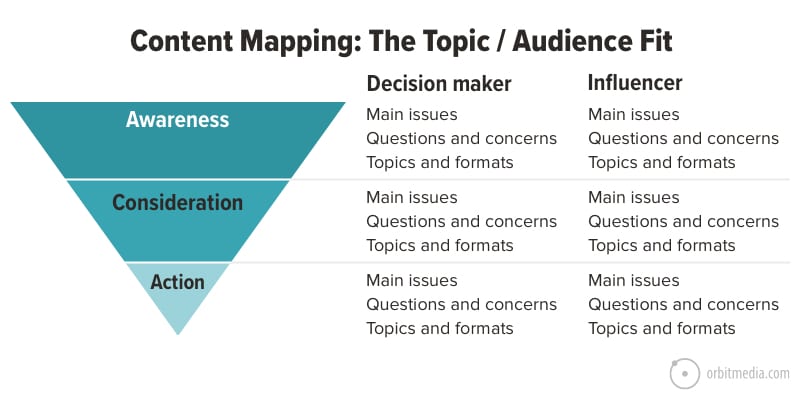
Empathy is the greatest marketing skill.
Mission
The very next step is to put yourself on a mission. This mission is a close relative to some other pieces that should already be in place.
- Businesses have mission statements. This describes why the company exists.
- Brands have positioning statements. This describes how they fit within the market.
- Content strategies have content mission statements. This describes what is published and for whom.
A content mission statement names the audience, the topics and the what’s-in-it-for-me for the readers. It’s similar to the publishing mission statements that newspaper and magazine editors have used for decades.
This basic element for content strategy was popularized by Joe Pulizzi, founder of the Content Marketing Institute. To document it, he recommends filling in these blanks:
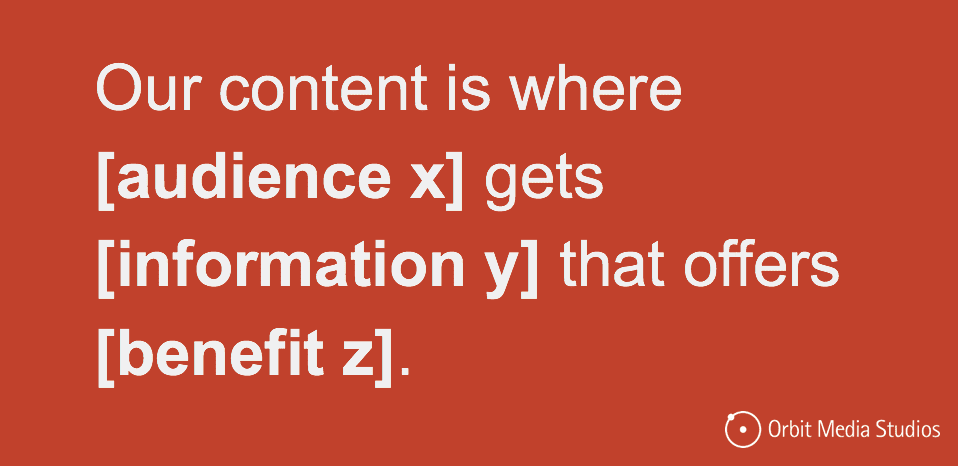
In our guide for writing content mission statements, we list the words they often include:
- Tips (most common)
- Advice
- Insights
- Strategies
- Stories (common for content programs at non-profits)
- Reports
- Ideas
- Inspiration
- Checklists
- Research (most effective)
- News*
- Trends*
*Note: There are fundamentally two kinds of content strategies: those focused on news and those focused on evergreen content. They have very different challenges and opportunities.
Your mission is the cornerstone of your content strategy. Write it down. From this day forward, this is your compass. Your guide. Everything you publish aligns with it. Everything you share (whether we wrote it or not) aligns with it.
The simple act of documentation increases the likelihood of success, according to CMI’s annual survey.
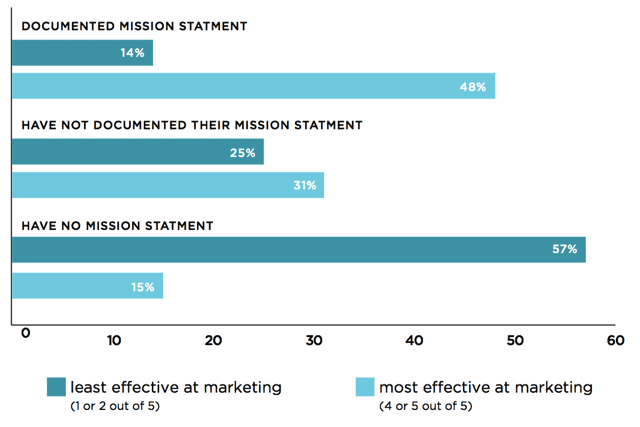
It’s also something you can easily repurpose into a call to action for new subscribers. More on email marketing below.
Topics
What to publish?
The best topics answer the questions your audience is asking. It helps them make a buying decision. Great content is either informative (learn), useful (do), or entertaining (feel). If we create something that lacks one of these three qualities, we might be in advertising mode. If so, don’t hit the publish button.
Ideally, you learn what your potential buyers want by listening, through conversations directly with the target audience.
If the marketers can’t ride along on sales calls. Good communication between teams can close the gap. Sales associates capture questions, pass them along to the marketers. Marketers then publish detailed answers, and the sales team can then pass them along to the next prospect who asks that question.
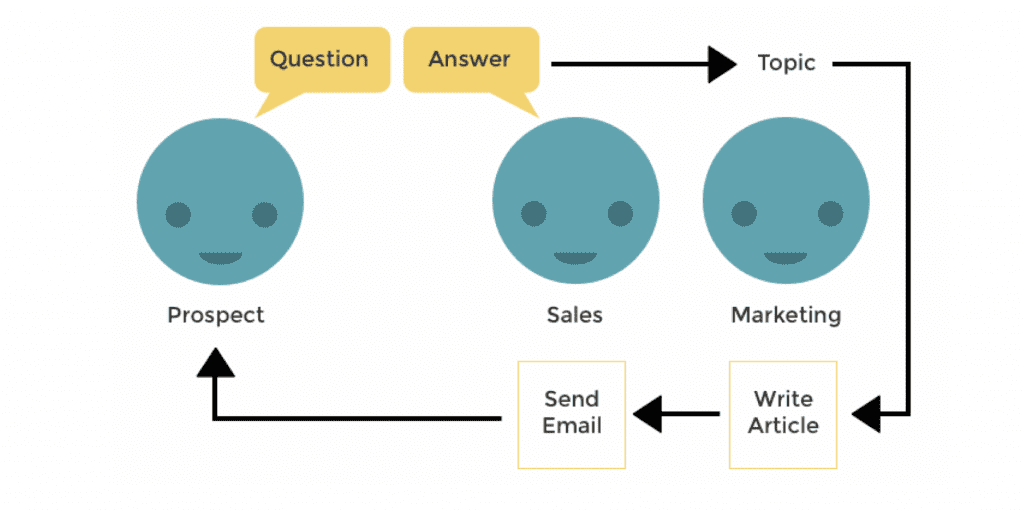
You can also use data to discover great blog topics. And sometimes, you can find a goldmine of content ideas in a single Google search…
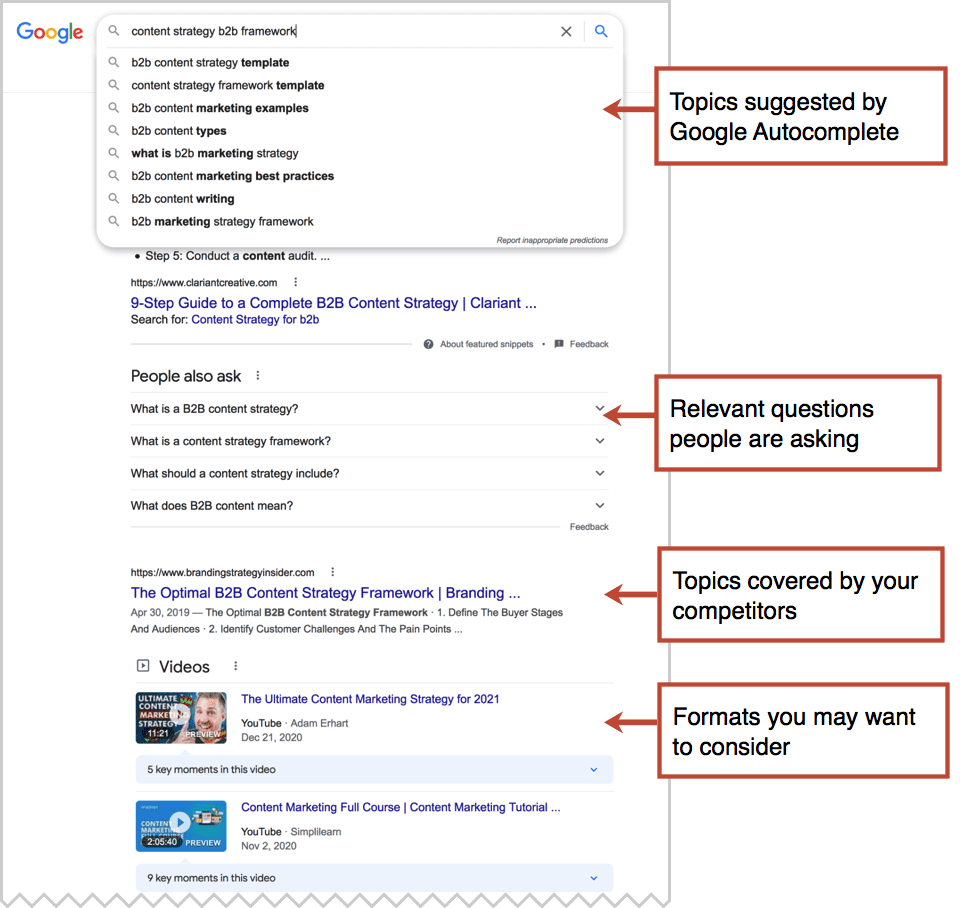
Our topics should connect to each other, fitting together like a hub with spokes. Creating content hubs both makes our sites more search friendly and more meaningful for visitors. The result of good content planning is a well organized set of pages.
Some pages show the big picture (like this one), others drill down and get very specific with prescriptive advice. Together, all of this content comprises our brand’s “lifetime body of work” …or LBOW.
This is also the time to think about the formats for our content. There are a lot of options. According to our annual blogging survey, some correlate with success more than others.
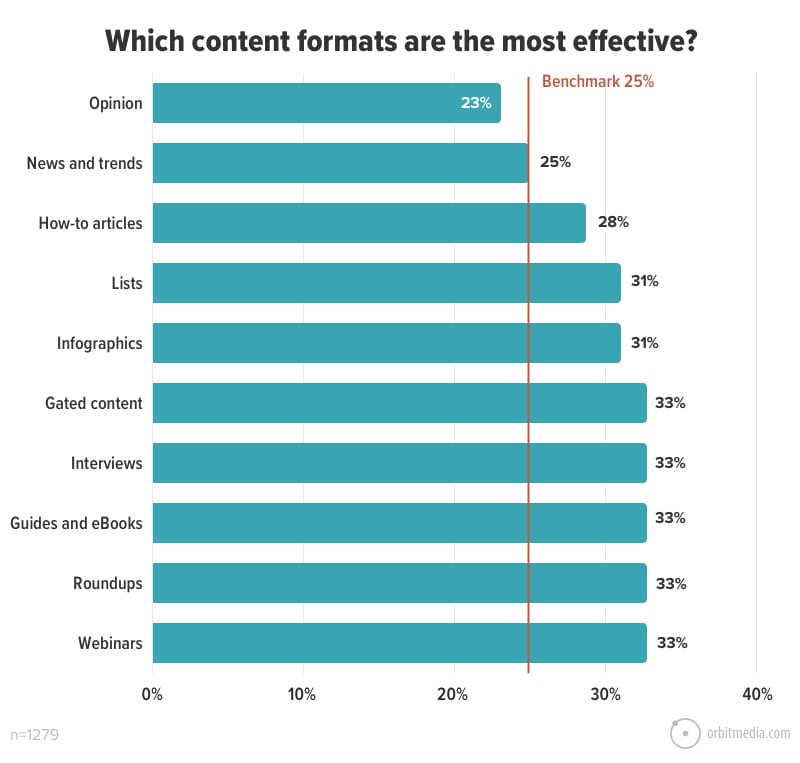
It can’t all just be written content. Visual content needs to be in the mix.
Keywords
It’s not necessary to build in keyword targeting and search engine optimization, but if you do, you’ll likely miss some big opportunities. SEO is a powerful and durable source of traffic.
Unlike social media and email marketing, which require continual effort (like oars on a boat), content that ranks in search engines has durable visibility, attracting visitors almost passively (like wind in a sail).
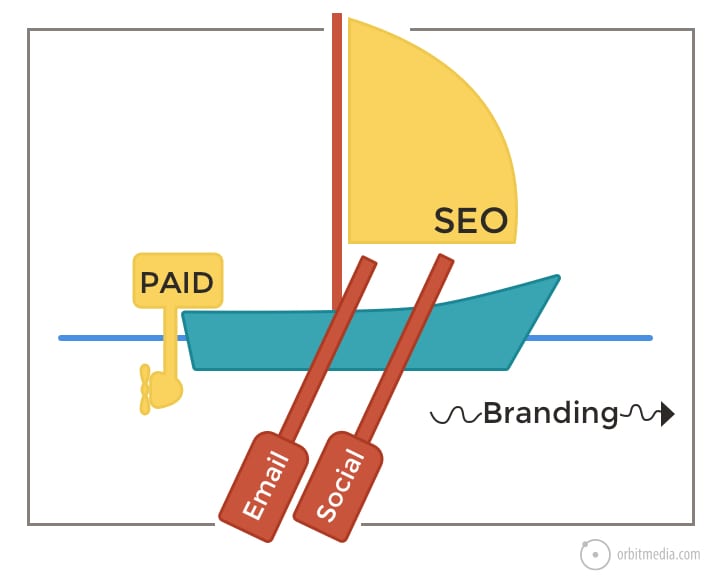
The best content strategies have an SEO component.
In fact, one of the big benefits of a content program is that it can build up the Domain Authority of a website, eventually helping your product and service pages rank for the really valuable keyphrases. We explain the mechanics in detail here.
Every keyphrase is a competition. Every page is a potential competitor.
But not every topic aligns with a keyphrase. Generally speaking, evergreen content (content that is relevant over long periods of time) has SEO opportunities. News does not.
Quick tip! The content marketers who win at search are those who know how to research keywords. They can quickly check both the popularity of a given phrase (search volume) and their chance of ranking for it (competition).
Influencers
This is one of the rare shortcuts in content marketing.
There are people in your industry who already have the attention of the audience you’d like to reach. They may be bloggers, editors, podcasters, journalists, authors, YouTubers, social media types, researchers, associations, media websites, event organizers, associations …you get the idea.
The key to influencer marketing is to “borrow” that audience in a sensitive and considerate way. It’s digital PR. (Of course, this is organic influencer marketing. Paid influencer marketing is advertising.)
Part of the magic of content marketing is that you are also a publication, so you can reach out to well-respected subject matter experts and invite them to contribute to your content (contributor quotes, roundups, interviews). This type of collaborative content marketing increases the chances that they’ll include you in their content.
This is what a formal influence marketing strategy might look like:
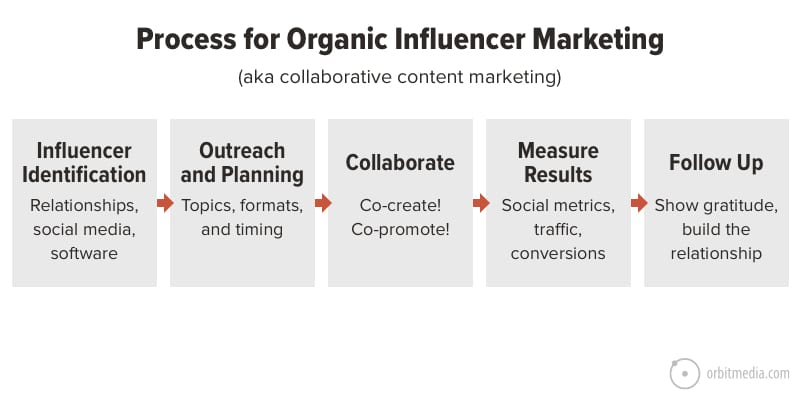
It starts with influencer identification. It is unlikely that you know them all. The best content strategists use software to find and track their relationships with influencers. You can also use social media to find influencers in any niche. It’s easy.
Quick tip! It’s best to start with non-famous subject matter experts. And when you are ready to pitch someone with a big personal brand, warm up the conversation on social media first. Engage with their content. Share and comment. Don’t pitch until you’ve interacted a bit in the social streams.
Never send a cold email.
Social Media Marketing
That’s one example of how social media works within a content strategy. As a research and networking tool, it supports influencer marketing.
Social media marketing is also an important channel for content promotion. It’s not necessarily the most effective channel, but it’s the easiest to get started with. It takes almost zero effort to share your content.
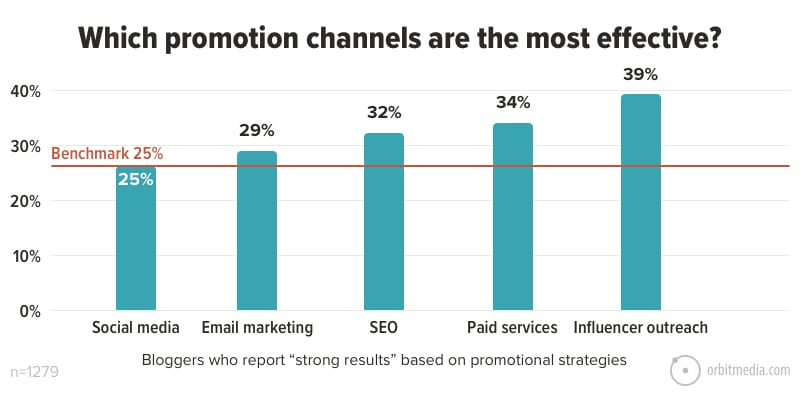
We all have our favorite social networks, but our goal is to be active in our audience’s favorite social network. Hopefully, you discovered this during our audience research above. And hopefully, you’ve already taken a little time to make friends there, become part of a community and build an engaged following.
Quick tip! For faster follower growth, adapt your content mission statement into your social media bio. Use it to let the potential follower know what you share. It’s a mini call to action, not an about us statement.
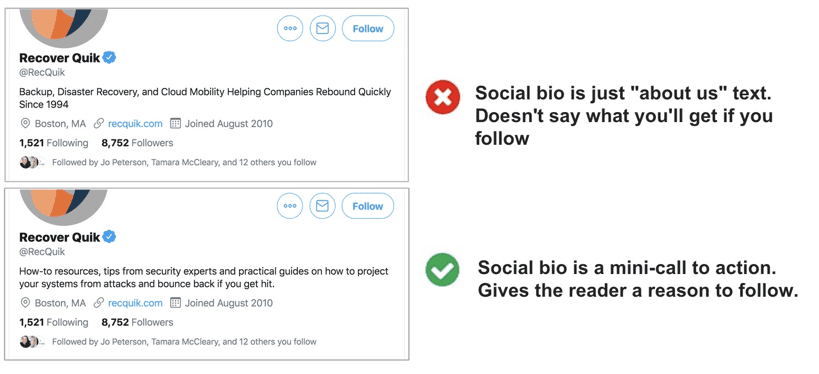
In the end content promotion is key to success.
The best content doesn’t win. The best promoted content wins.
Email Marketing
Every serious content marketer I know is actively working to grow their email list.
That’s because email marketing is disintermediation. Unlike search and social, there is no giant tech company between you and your audience. You don’t own your search rankings or your social media connections. But you do own your email list.
When a visitor subscribes, they are giving you permission to contact them directly. That’s magical.
This makes email marketing one of the most important sources of traffic. When tracked properly using links with campaign tracking codes, the traffic appears separately in Google Analytics.
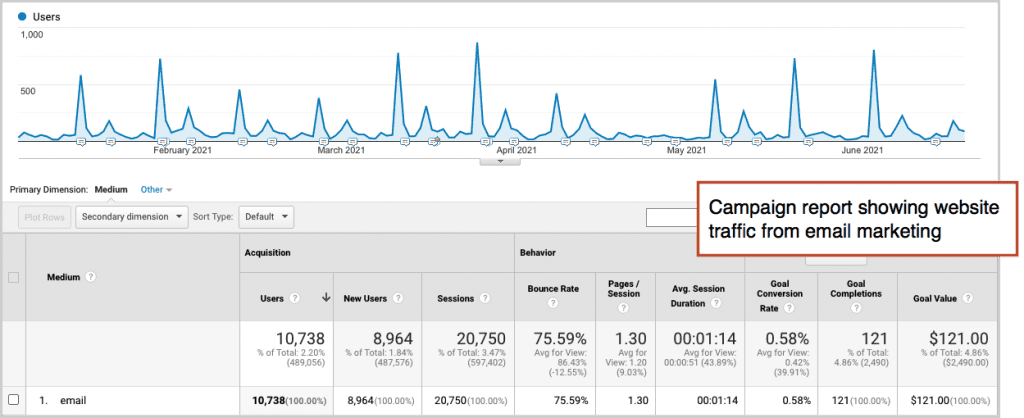
Quick tip! Use a human sender name.
It’s psychologically more difficult for your subscriber to delete or unsubscribe from an email if it comes from a person. Changing the sender name from a company name to a person’s name can increase open rates by up to 20%.
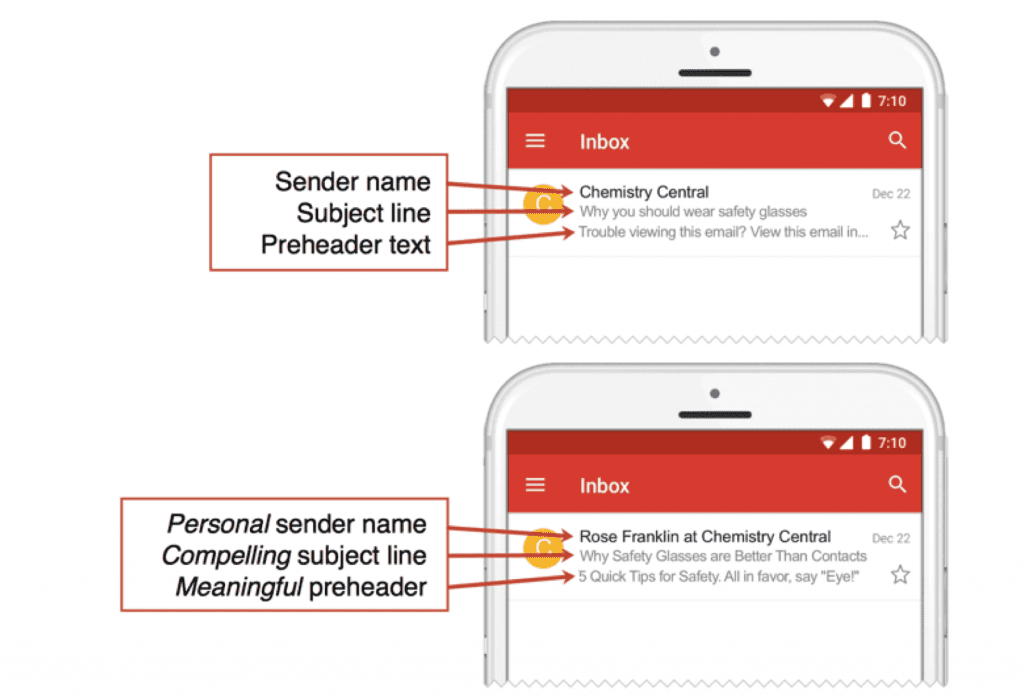
The Plan
Now you have documented who you’re targeting, what you’re publishing, how it will be promoted. You should also have some idea for which influencers you are collaborating with, which formats you’ll be using and also how often you’re going to publish.
These are the basic elements of your content strategy. Assign roles and put everything on a content calendar and you’ve a plan in place. It’s all part of the digital marketing process.
A few quick final thoughts that highlight the difference between good and great content strategies.
- Not just blog posts.
Create content in different formats – videos, guides, infographics – whatever our audience may like. - Not just on your own website.
Publish different places – the blogs, media sites, podcasts and social networks where your audience spends time. - Not just created by you.
Work together with influencers to co-create content that your audience will love and the influencer may share.
Measure and Optimize
We started with a quick definition of content strategy, which in a simpler form is a plan to use content to reach a specific marketing goal.
Like any plan to reach any goal, you’ll need to measure your progress to keep yourself on track. Content marketing is a marathon. It’s a long-term process. Unless you track your progress, you’re likely to get discouraged and give up.
Track your activity
- Total number of assets published
- Assets published per content type (articles, original research, videos, infographics, influencer collaborations, webinars, etc.)
I’ve tracked all of my publishing since day one. Seeing it all on one chart keeps me motivated.
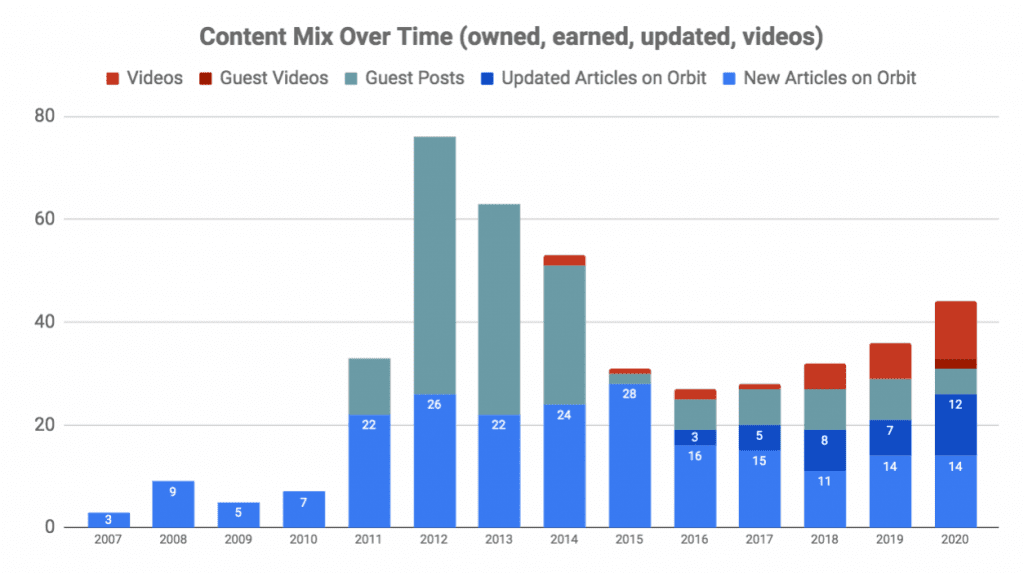
Track your progress
- Total website traffic
- Website traffic from various traffic sources (search, social, email)
- Total conversions
- Conversion for each specific goal (subscribers, event registrants, leads)
- Links and mentions from other websites
Of course, there are many other content marketing metrics you can track. Be careful with these. The most visible metrics are usually the least useful.
After the first year of content development and promotion, driving your editorial calendar and running content marketing campaigns, you’ll be ready to run a content marketing audit. Follow this process to see which of your content marketing efforts are getting 10x results, and which blog posts have the best opportunities for updates in their content lifecycle.
Here is a final thought to keep you on track. It’s from James Clear, author of Atomic Habits. He reminds us that real results and expected results don’t line up. It’s easy to get discouraged.
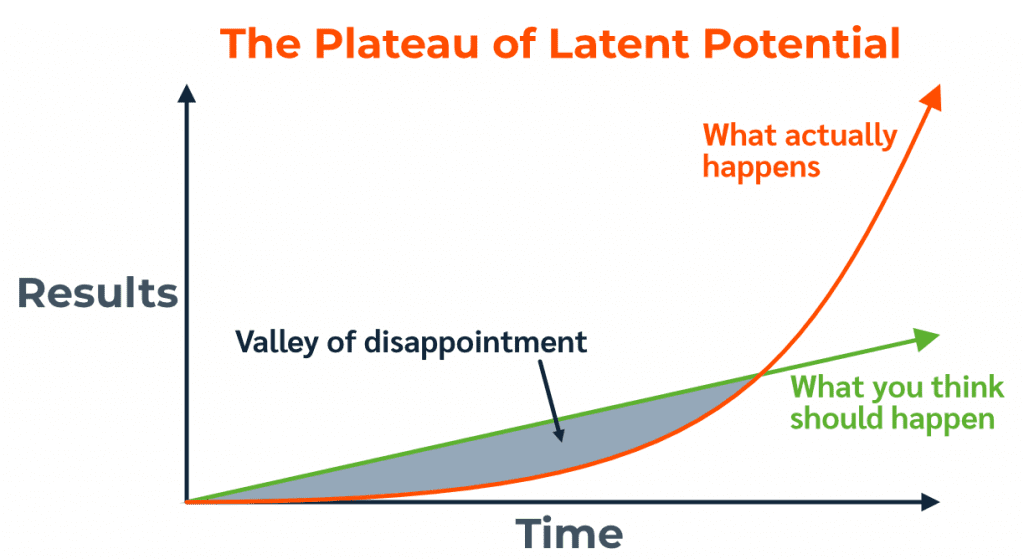
This applies to the experience of so many content marketers. Results are slow at first, but the benefits are durable. It’s like a flywheel. It gets easier. Eventually, you’ll create cumulative advantages that will make your business very very hard to compete with.
Hang in there, people. Most of your competitors will give up. But keep going. It’s worth it!
Content Strategy vs. Content Marketing Strategy
I’ve used the term “content strategy” in this article and video to discuss strategic considerations for content marketing. But actually, there is more to content strategy than just marketing.
I have no specific expertise in the broader, content strategy topic. But Hilary Marsh does. Hilary has done content strategy work (both for marketing and non-marketing content) since the 1990s. She is an expert on the topic and the Chief Strategist at Content Company, LLC.
To clarify, I asked Hilary to explain the difference…
Content strategy – more than content marketing strategy
The terminology is confusing, isn’t it! I don’t think we do ourselves or our clients/colleagues any favors when we use “content strategy,” “content marketing,” and “content marketing strategy” interchangeably. Even the read-aloud video on this page mixes up the terms: The text inside the video says “content strategy,” but the title slide and the YouTube title both say “content marketing explained.”
The definitions differ too. This article says content strategy is the practice of planning the creation, promotion, and measurement of content, and that it’s really a plan for content marketing. But that’s not actually all there is to content strategy.
Here’s my definition:
Content strategy is the practice of planning for the creation, delivery, and governance of useful, usable, effective content.
Let’s explore each of these new terms:
- Delivery refers to any channel the content may be published in: the organization’s website, technical manuals, social media channels, e-newsletters, print brochures, etc.
- Governance means setting up the publishing system, with workflows and roles/responsibilities for content creation, review, publishing, maintenance, taxonomy, etc.
- Useful means that it’s relevant to the audience; usable means that its benefits are clear; and effective means that it has a clear, measurable goal and can achieve that.
The disconnect and confusion arise because “content” itself has so many meanings. For content marketers, content is what they create. It’s marketing-focused content – campaigns, testimonials, lead-focused landing pages, and the like. Since the goal of marketing content is drawing prospective customers, or leads, there’s no need to include that in the definition. And since the content is forward-looking, governance is pretty straightforward:
- Marketers decide on the content
- Marketers create the content (whether themselves or via an outside writer)
- Marketers approve the content
- Marketers (hopefully) remove the content when its useful life is over
Every organization creates much, much more than marketing content. As I like to say, content is the way an organization’s work manifests itself in the world. Every product, service, or resource ends up in the world as words, pictures, audio, and/or video – aka, content.
- For corporations, content is their products and the ecosystem around them. For example, an automobile manufacturer’s cars are content, as far as digital is concerned: Not only the marketing content, but all of the information about the cars, from the product specs to the customization to the owner manuals.
- For associations, educational institutions, and nonprofit organizations (most of my clients), their products and services are content: Events, courses, advocacy initiatives, knowledge bases, industry standards, etc.
- And every organization has information about itself, its leaders, its news releases, etc.
That’s where content tends to get complicated, and where content strategy can make a huge positive difference for a company. At its heart, content strategy helps an organization answer three basic questions for every piece of content:
- Who is this content for (and how do we know they need it)?
- What is our measurable goal for publishing this content?
- What other content are we creating to serve this audience and with this goal?
These may sound like straightforward questions, but they’re usually extremely challenging ones.
In my 20+ years as a content strategist, I’ve seen several universal issues with organizations’ content:
- Different types of content are created by people with deep subject-matter expertise but who are not professional writers
- Content creators in different silos (product development, customer support, etc.) don’t talk to each other
- Subject-matter experts are not held accountable for the quality of the content they create
- The organization doesn’t make the time or resources available for ensuring that content can achieve its goals.
Content strategists roll up their sleeves and, armed with an understanding of the organization’s goals and challenges, as well as the top-priority audiences and their needs, help the organization create the necessary roles, processes, and standards so that ALL of its content works.
The good news for all of us is that the better the organization’s content strategy, the easier the content marketer’s job is, because after the compelling testimonial or landing page, the prospective customer who explores the rest of the organization’s content will have a better, more holistic experience. Then the marketing content can do its job more effectively.




